Get to know Conversations
Once you have set up the environment, the agents can start managing conversations and customer inquiries. All conversation management happens within the Agent panel.
To start, the agent needs to log in to the Infobip web interface (opens in a new tab) and go to Conversations on the left menu navigation.
For performance optimization, agents should mark their availability by changing their status when taking over a conversation. The status reflects several things, however, it is important because this way supervisors can track and manage team capacity in real time.
To change the status, the agent should navigate to their User profile in the bottom left corner → Choose status from the drop-down menu below their agent name and profile picture.
The default status is Active and the agent can change this status at any time.
Available statuses are:
- Busy
- Offline
- Away
Agents can set these per their current workload to denote their availability in the contact center.
Agent panel consists of two main areas:
- My Work - Displays all conversations the agent is working on at the moment
- All Work - Shows all conversations and queues
Dark mode
Dark mode is available for agent panels in Conversations, which significantly improves the user experience by reducing eye strain and provides a consistent and more accessible environment for agents.
To enable the dark mode, select the sun icon ☼ in the upper right corner of the agent panel.
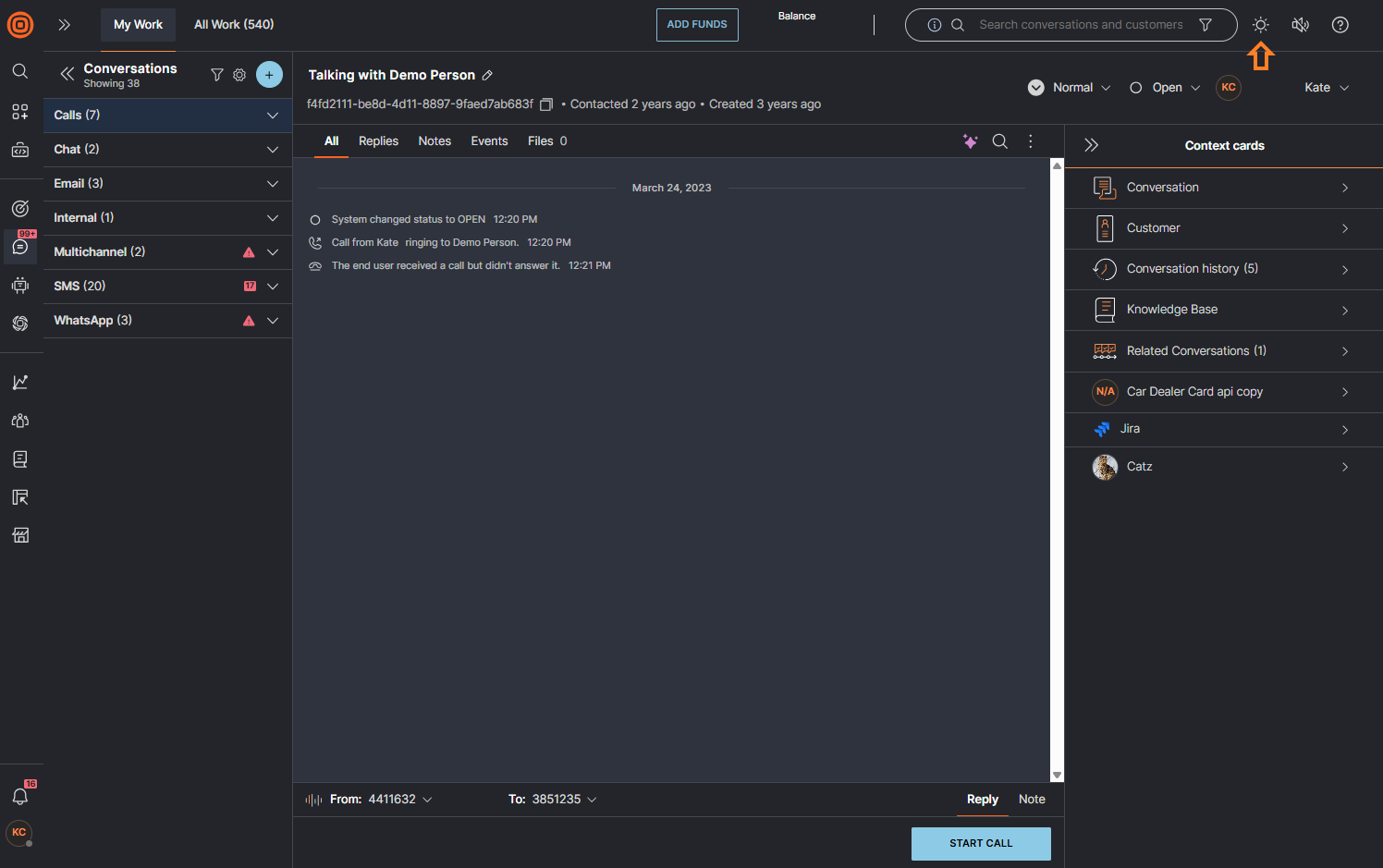
Once you enable the dark mode, the complete agent panel will be affected, including:
- All Work (all belonging tabs, cards, and modals)
- My Work (all belonging tabs, cards, and modals)
Information about the selected mode is stored in local storage. Therefore, transitioning to another part of the portal that remains in the light mode will not change the settings, and the Agent panel will maintain the selected mode when you return to it.
Furthermore, it is important to note that a refresh or daily login will not alter the mode you have configured. It will remain as the one you have selected until you change it either by clicking the moon icon mentioned earlier or until you delete the stored cookies, which will reset the mode back to the light one.
To switch back to light mode, select the sun icon ☼ again in the upper right corner.
All Work
All Work is a platform designed for supervisors and agents to list and group conversations based on specific criteria. The Infobip platform offers predefined views and allows users to create their custom views.
The All Work panel encompasses conversations and queues, including those assigned to others. Conversations are grouped into views defined by filters, and these views can be private or global.
- Predefined views contain views that are industry standards and which help users to better navigate between conversations.
- Global predefined views:
- Unassigned - All open conversations without the assignee
- All - All open conversations regardless of the queue
- All Chatbots - All conversations currently handled by bots
- My Conversations - All open conversations assigned to the user regardless of the queue
- Internal - Consists of internal conversations
- History - Consists of all closed conversations regardless of the queue
- Callback - Consists of the required callbacks
- Global predefined views:
- Custom views allow users to create filters and cover some specific cases that they often filter and these views can be:
- Private - Each user can create views for themselves. These help individual users to organize conversations and be more productive and are visible only to the creator.
- Global - A set of views available to all users. Supervisors can create these views for all agents to use which will help them manage conversations more efficiently.
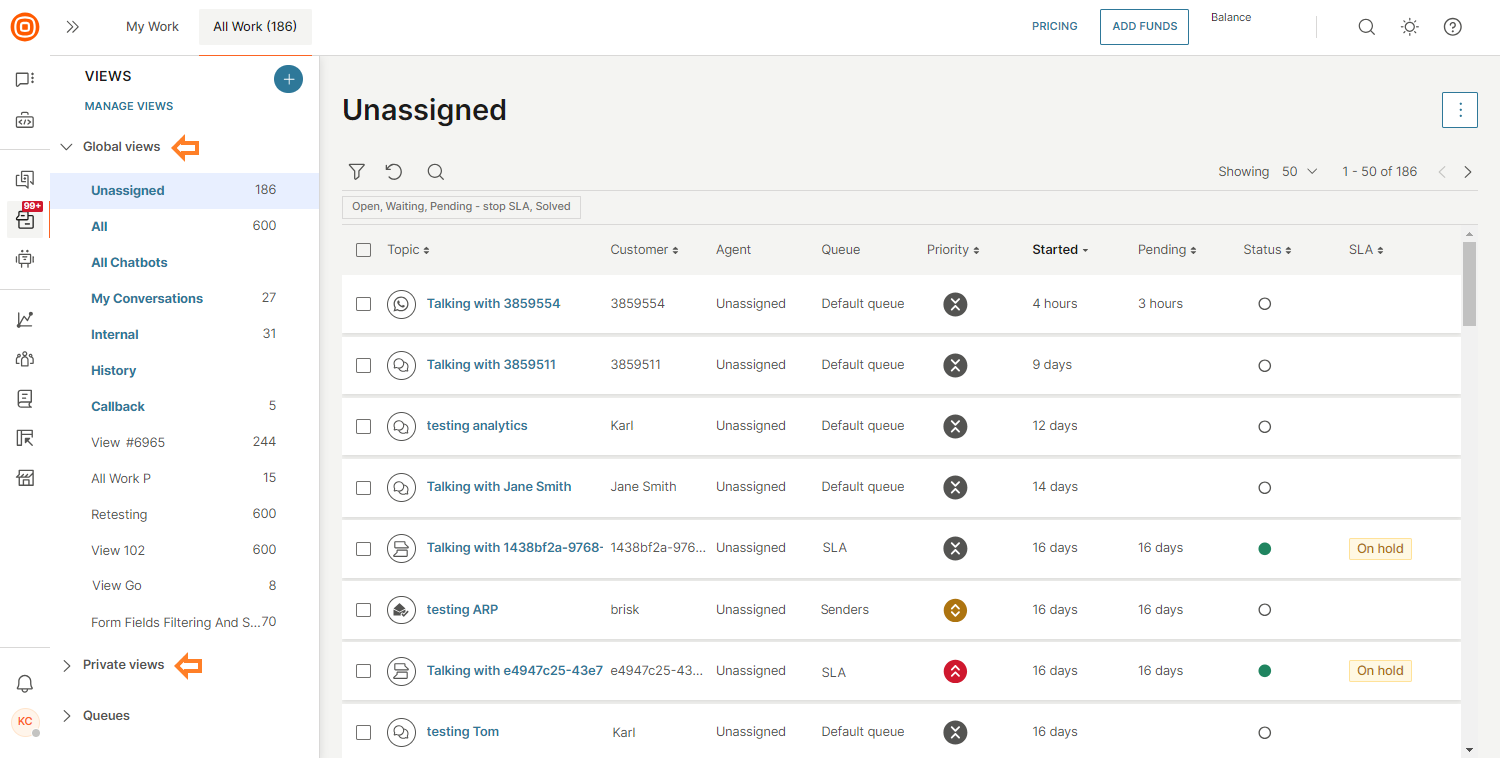
When you click on a specific queue/view, a list of all conversations within that queue/view will appear. Usually, the oldest conversations are displayed first, and the correct default sorting is indicated by pending time.
Agents can open a conversation by clicking on it or assign it to themselves by selecting the conversation(s) and clicking the Assign To Me button.
Click on the table header to sort by customer, priority, requested, or pending. By default, all conversations are sorted based on the pending column in descending order to alert to the longest waiting times from the customer end.
Sorting and filtering
You can do the sorting by many of the custom-added columns by clicking on the header indicated by the arrows. The most common sorting is done by customer, priority, status, or pending. By default, all conversations are sorted based on the pending column in descending order to alert you of the longest waiting times from the customer's end. Additionally, more advanced filtering options are available in All Work under Filters:
- Predefined attributes:
- Channel - Type of conversation channel
- Queue - Queue to which the conversation is assigned
- Callback type - Automated/Manual
- Callback status - Active/In queue/No reply/Done
- Callback pending since - Duration for which a callback is awaiting resolution
- Origin - Inbound or outbound conversation
- Priority - Priority of the conversation
- Status - Status of the conversation, which cannot be combined with the Closed and other statuses. Users can choose Open, Waiting, or Solved (which can be combined) or Closed (not possible to combine with other statuses)
- Pending agent reply - The duration for which the customer has been waiting for a reply from an agent
- Handling time - A time range from below 5 minutes to more than 5 days
- Agent - Specific agent to whom the conversation is assigned
- Tags - One or many tags assigned to the conversation; when multiple tags are selected, users can also choose the operator that can be ALL (meaning AND between tags) but can also be ANY (meaning OR between tags)
- Sentiment - Three available options representing the sentiment of the conversation: positive, negative, or neutral
- SLA:
- Assigned SLA policy - Identifies all conversations with an assigned SLA policy
- SLA breached by - Time-based filter that provides a list of conversations that have already breached the chosen timeframe
- SLA breaching in - Time-based filter that provides a list of conversations that are close to breaching in the chosen timeframe
- SLA severity
- Conversations forms and form fields:
- Conversation form - Filters conversations based on the assigned Conversation form
- Form field - Filters conversations based on specific form attribute values that are configured
- Date:
- Conversation starting date - Time range when the conversation has been started by an agent or the end customer
- Conversation closing date - Time range when the conversation has been closed
- Callback creating date - Date range when the callback has been created, only available as a filter in the predefined Callbacks filter
- Last updated date - Date range when the last conversation update (message from the agent, call, and callback) occurred
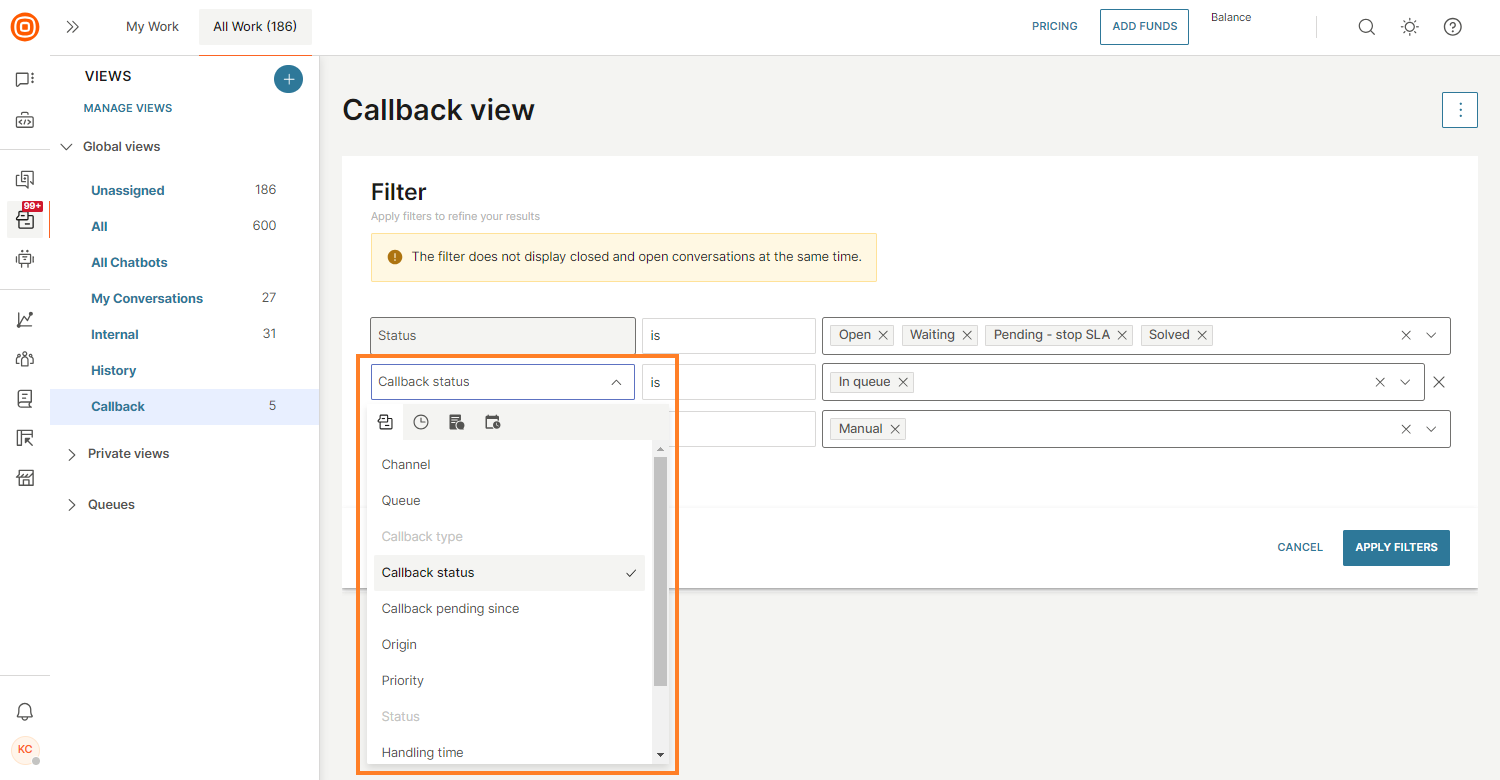

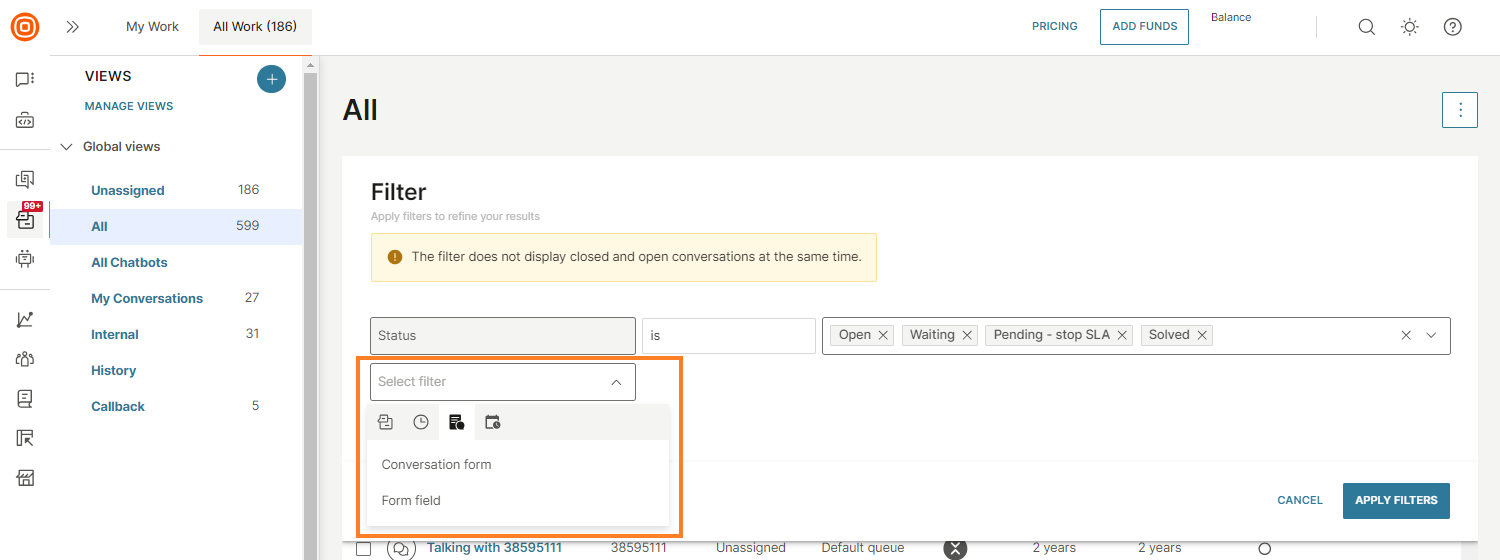
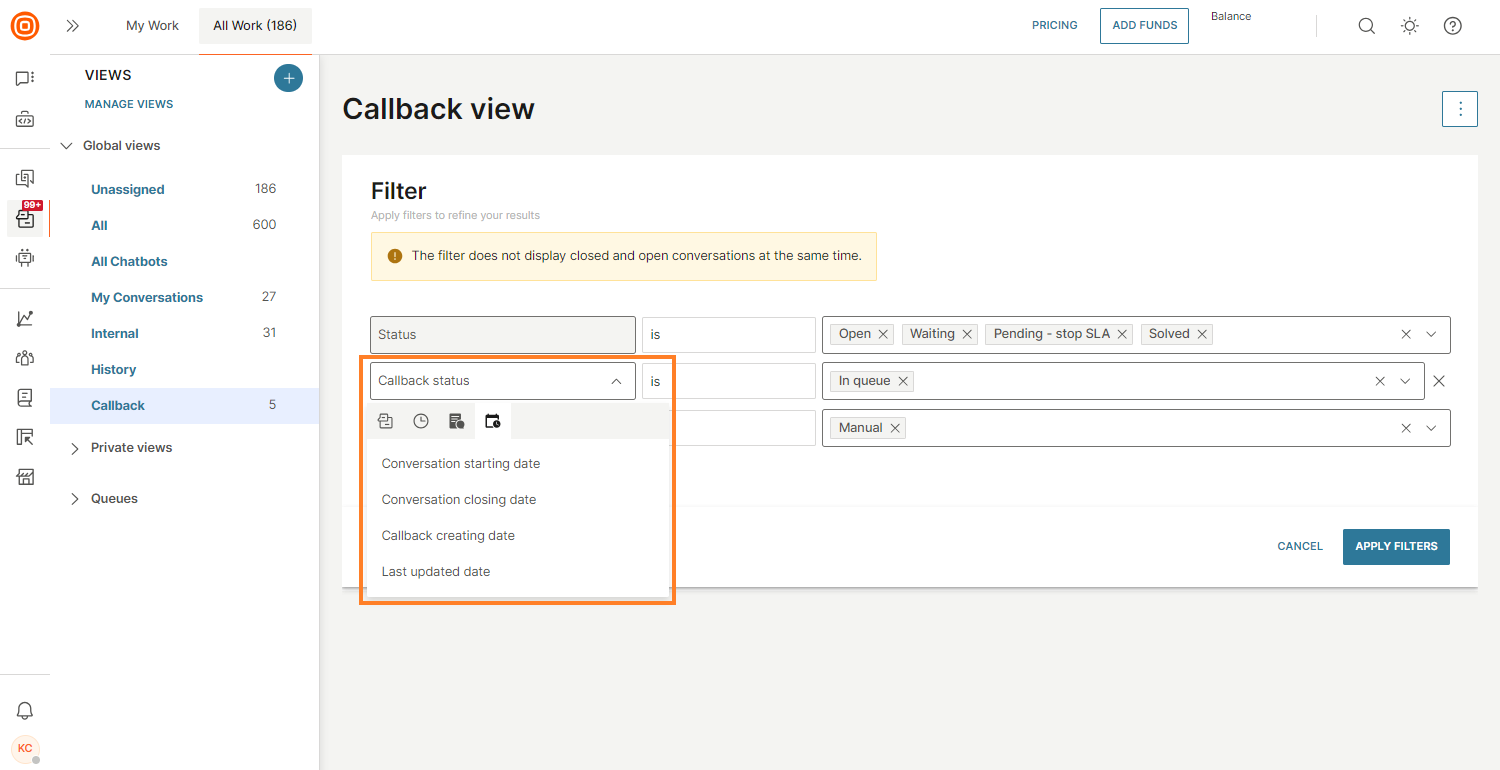
Closed conversations filtering and querying
In All Work, closed and non-closed conversations are placed separately in dedicated views, which means that these conversations cannot be filtered together.
Whenever a conversation is closed, it is placed in the History view, but you can create exclusive custom views (private and global) for closed conversations only.

The private and global custom views support either the selection of closed or non-closed status in the filter. Selecting one will automatically disable the other.
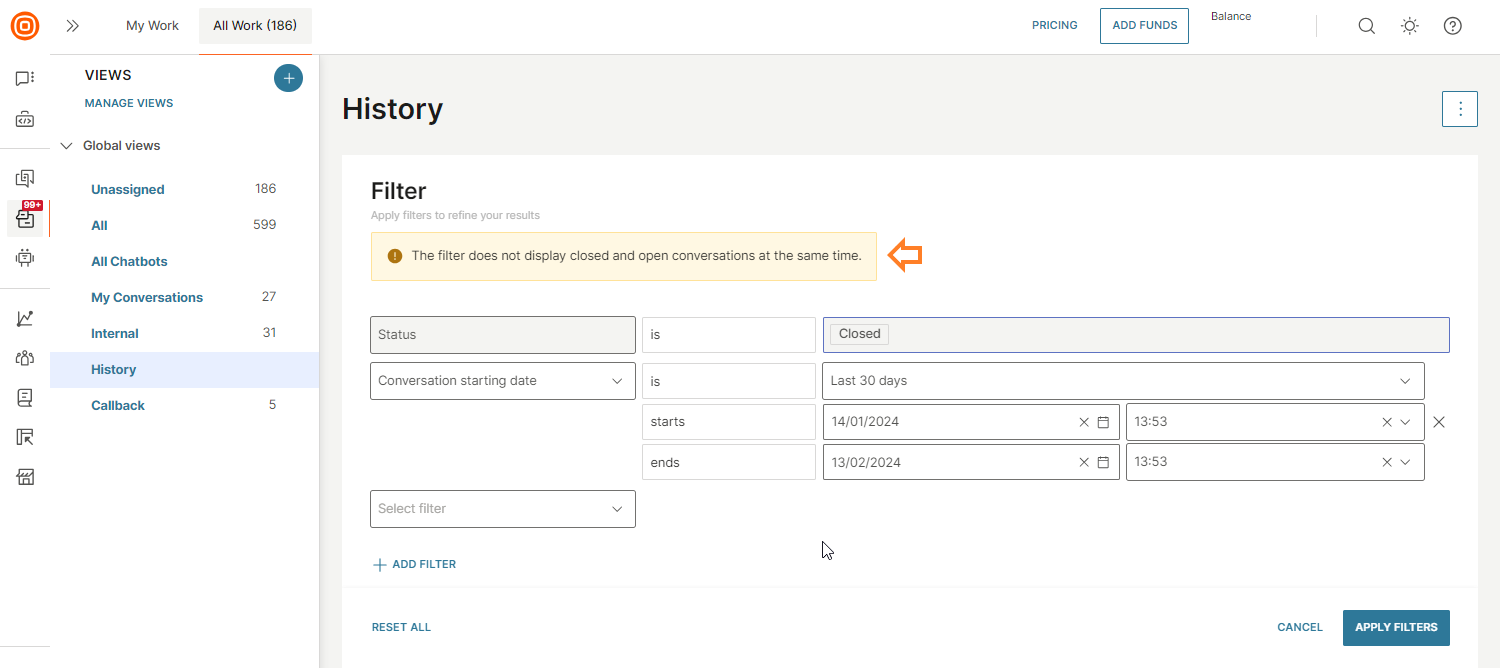
Temporary views created from Analytics show a generic warning message that by default only non-closed conversations appear, but the Closed status can be explicitly selected in the filters.
It is recommended to enter the conversation start date to get better results when filtering conversations.
Service-level agreement
If the supervisor has successfully set up at least one SLA policy, this will be displayed in the All Work panel as a new column so agents can see the SLA for every conversation, where applicable.
This column offers the following information:
- SLA time closest to achieving the breach
- Or SLA time which has the largest breached time (if both currently counted SLA timers have already been breached)
SLA timers are tracked only for non-closed conversations. Closed conversations will not display any times in the SLA column.
Agents can also use the filtering options and check the conversations regarding SLA only:
- Assigned SLA policy identifies all conversations with an assigned SLA policy
- SLA breached by is a time-based filter that provides the list of conversations that have already breached the chosen timeframe
- SLA breaching in is a time-based filter that provides the list of conversations that are close to breaching in the chosen timeframe
Queues
Below Views, in the Queues section, you can find specific queues. Queues consist of any queue defined by the supervisor combined with the default queue. The Default queue consists of all open conversations that did not land in any user-defined queue. Each agent can see only those queues they are assigned to as a resource while supervisors have access to all queues.
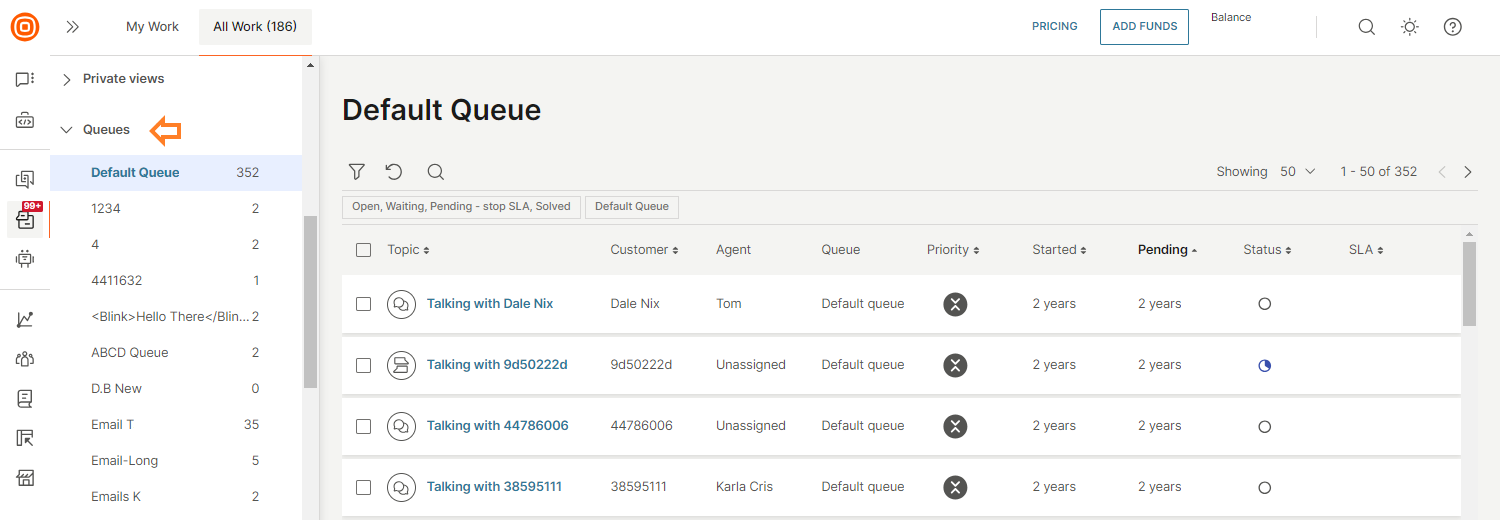
To learn more about queues, refer to Queues.
Bulk actions
Users often need a way to modify several conversations at once for example, an agent is on sick leave so all their tasks should be shared among the team).
The following bulk actions are available in the All Work panel:
- Assign/reassign list
- The Reassign button appears after the conversation(s) are selected and clicking it enables the selection of agents to whom the conversation can be reassigned
- The assignment logic follows the regular assignment rules (for example, a conversation cannot be assigned to an agent who is not part of the current conversation queue)
- Change queue
- Click the action to display a searchable list of available queues.
- Change status
- Change the status by clicking on the 3-dot icon to select the action.
- Change priority
- Navigate to the 3-dot icon to select the action and change the priority.
- Add tags
- Apply one or more tags to multiple conversations simultaneously.
- Download conversation transcripts
- Check the section below and find out how to download conversation transcripts

Download conversation transcripts
Download all selected conversations (up to 100) and create a .zip file storing them in selected file format (.txt or .xlsx).
To perform any of these actions, either check the upper left check box which selects all the conversations on the list, or select the checkbox next to a specific conversation. Once you choose the conversation transcript(s) that you want to download, click the three dots menu → Download conversation transcripts option.
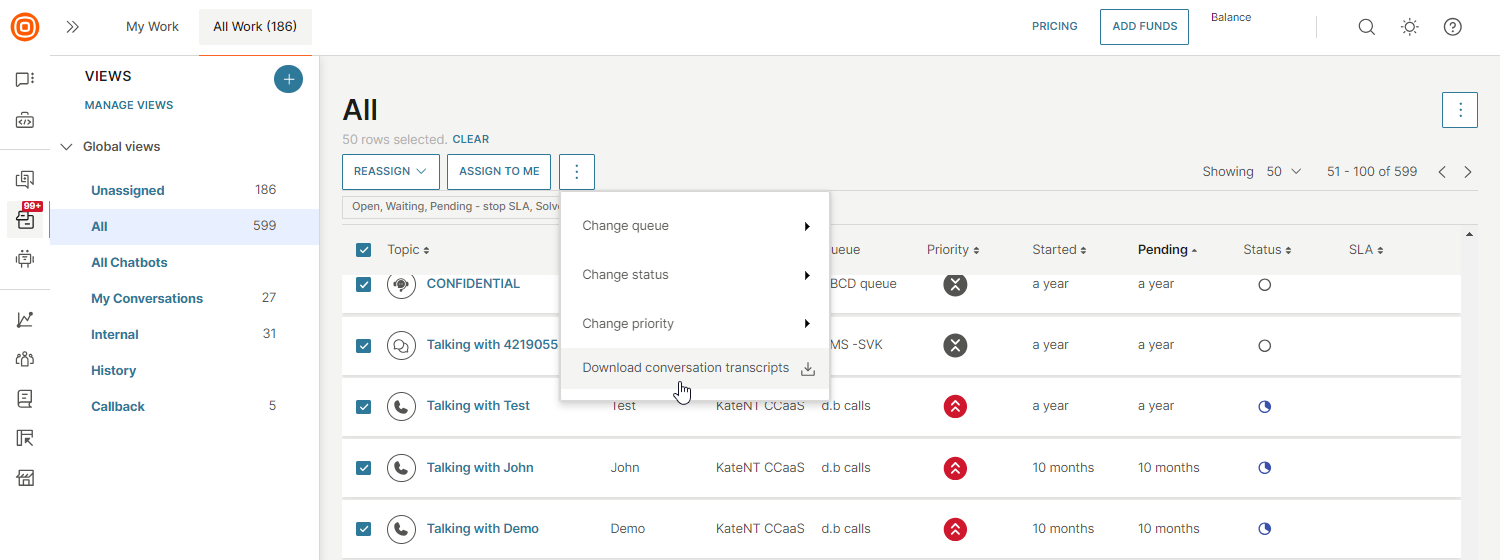
Persistence in All Work
The persistence in switching between the All Work and My Work tabs is particularly important when agents manually select their work and do not want to lose track of where they picked a conversation from.
With tab switching, you can access the last state of the page you visited, and with the back button, you can access multiple saved states of the pages. The system remembers the page, scroll position, filters applied, and more.
Persistence is on two levels:
- Persistence when switching between All Work and My Work tabs - When you select a conversation from All Work and click to open it, the conversation is expanded under the My Work tab. When you return to the All Work tab, you are directed to the view, filters, and scroll position you started with. The nature of persistence in the tab switching enables you to access the last saved state of the page.
- Persistence when clicking the back button in the browser - When you select and open a conversation from All Work, the conversation is expanded. When the back button is clicked, you are taken to the last page and its saved state.
Upon returning to the All Work page, the opened conversation is highlighted, and if it happens to be located lower on the page, the system automatically scrolls to ensure the conversation is visible.
CDP Data
Digital channels
The CDP data in Digital channels (WhatsApp, Viber, SMS, MMS, Voice, Video, Live Chat, In-app Messaging, Messenger, Instagram, Telegram, KakaoTalk, LINE, and Apple Business Messages) reflects differently on the Topic in All Work and My Work based on the following:
- Conversation is created (and if the customer does not exist in CDP) - For each digital channel, a different ID (customer number as fetched by the gateway) is used as a default if the first name is not present (Talking with).
- Customer exists in CDP (and is linked to the conversation) the topic is presented as Talking with.
- Customer info is updated/linked to a different profile.
- CDP profile is updated while the Conversation is closed; in the three cases above, the display name from CDP is updated only when the Customer Context Card is expanded (Talking with).
The Customer Context Card in My Work is also impacted differently considering the following events:
- Conversation is created (and if the customer does not exist in CDP) - Customer name (name or ID as fetched by the Gateway) is displayed and other selected attributes on the Customer Context Card are displayed with NULL values.
- Customer exists in CDP (and is linked to the conversation) - Customer name and other selected attributes on the Customer Context Card are displayed and updated on the expansion.
- Customer info is updated/linked to a different profile - The Customer Context Card is expanded to unlink or link to a new profile.
- CDP profile is updated while the Conversation is closed - Customer name and other selected attributes on the Customer Context Card are displayed and updated on the expansion.
My Work panel
My Work is the main agent dashboard where agents can:
- Check conversations assigned to them
- Check details about each conversation
- Manage conversations and conversation details
- Create new conversations
On the left side, agents can see the list of conversations assigned to them. The conversations list contains conversations with the following status:
- Open
- Waiting
- Solved (depending on the configuration)
They are listed by date of the last customer message received (last received is always on top of the list).
For each conversation, in the right-side panel, agents can check the following:
- Timestamp of the last received message
- Customer name
- Preview of the last received message
Also, conversations containing unread message(s) will be marked as bold and the counter with the number of unread messages will appear next to it. Conversations marked as Closed are not shown on the list.
The left side panel contains recently viewed conversations but you can also see all conversations that the agent has checked recently regardless if they were assigned to them or not.
When a conversation contains unread messages, the notification indicator appears until the conversation is opened. Click + to start a new conversation. Each conversation is opened and managed in My Work.
Within the selected conversation, the agent can do the following:
- Type, send, and receive messages
- Change conversation priority, topic, and status
- Type public notes
- Reassign conversation - the Agent can take unassigned conversations or move their conversations to other agents. The agent cannot take over conversations assigned to other agents.
However, supervisors can change the assignee without limitations:
- Change queue
- Type summary
- Manage tags
- Manage customer profile
The main part of the conversation is the interaction between agents and customers where agents can see the conversation history. Conversations is a true omnichannel platform. For example, if the customer uses messages to establish their brand on one channel and then later on another channel, messages can be part of one continuous conversation.
When a customer message is received for the first time, a conversation is created with the following attributes:
- Conversation name
- Conversation ID
- Participants (customer/agent(s)/bot)
- Date of creation
- Message status (default one is Open)
- Message text
- Message channel indicator
- Customer info (if customer recognized)
Sound notifications
To enable or disable sound notifications, click on the speaker icon located in the upper right corner. The sound notifications are disabled by default.
In some cases, the browser may prevent sound from playing when a notification arrives, even if the agent has enabled sound. This can occur if the agent does not have time to interact with the page before the notification arrives, or if the web interface is simply loaded and the agent does not interact with the page. The notifications will still be displayed, but the browser will not allow sound to play to avoid disturbing the website visitor. To resolve this issue, the agent must manually enable the "Sound" permission in Chrome or the "Autoplay" permission in Firefox or Safari.

Mark message as unread
Sometimes agents will see customers’ messages but cannot handle them right away, and these messages are automatically marked as read. You have the option to mark messages as unread so that they do not end up unnoticed, meaning that you can get back to them as soon as possible.

Message bubbles
To improve visibility for agents inside the conversations window, customer messages are aligned to the left side while keeping the agent messages aligned to the right.
Message status
Different message statuses can occur:
- Single grey tick ✓- The message is in the sending process or if a channel does not support message delivery status, and the message has been sent out from Infobip, but it is unknown if the provider has received it or not, means that the message is in the sent process.
- Double grey tick ✓✓ - The message has been delivered to the user.
- Double green tick ✓✓- The message was seen by the user.
- Red triangle ▲- A delivery error occurred or the processing failed.
Message preview
The Message preview feature allows agents to quickly preview the conversation details without opening the specific conversation. With this, they can easily review the message content, understand the urgency of the matter, and prioritize the conversation among all the others, resulting in faster resolutions for customer issues.

Message errors
In instances where a message fails to be delivered, you will be provided with detailed insights including the error code name and ID.
With this information, you can pinpoint the underlying reasons behind message failures, enabling a more focused and efficient approach to tackle any potential issues.

Refer to the following page which contains a comprehensive list of all codes and actionable steps necessary for resolving any encountered issues: Response status and error codes.
Filter conversations by status
To filter conversations by status, click the filter icon in the My Work side panel.
From there, you can filter your current conversations by selecting from the following statuses:
- Open
- Waiting
- Pending - stop SLA
- Solved

If the Solved status is greyed out from the filter, it indicates it has been set to be hidden from My Work.
Sorting, ordering, and grouping
The sorting, ordering, and grouping options in My Work efficiently organize, prioritize, and group conversations, reducing manual work and offering a clearer view of priorities.
Select the cog icon in the top-right corner to access the following options:
- Sort by
- Order by
- Group by

Sort by
The Sort by option offers the following sorting possibilities:
- Conversation updates (lists conversations sorted by the most recent date and time of modification)
- All messages (lists conversations sorted by the time and date of the last message sent by either the agent or the customer)
- Customer messages (sorts based on the customer's messages)
- Conversation assigned (lists conversations based on the time and date when the conversation was assigned to the agent)
The default sorting is set to Conversation updates. The following actions will influence the sorting under this option:
- Conversation created with message
- Assigned, reassigned, unassigned
- Conversation merged
- Message sent/received
- Conversation callback
- Create note
- Route conversation
- Auto assignment
- Add/remove conversation to/from queue
- Unbind/bind the form
- Link/Unlink customer
- Change (priority, status, summary, topic)
Order by
The Order by option offers the possibility to order the conversations by:
- Newest on top
- Oldest on top
Group by
Lastly, the Group by option allows you to organize conversations based on:
- Status
- Queue
- Priority
- Channel
This feature enables you to group and customize your conversations on the My Work page, offering more flexibility for your specific needs and use cases. Sorting and ordering are implemented within each group.
For Queue and Channel grouping, agents will only see groups where they have at least one assigned conversation. For instance, if an agent belongs to 10 queues, they will only see the queues that contain their assigned conversations. As a result, the list of groups updates dynamically. Additionally, these two groups are sorted alphabetically.
For Status and Priority grouping, even if an agent has no assigned conversations, the groups are still displayed but without the option to expand them. For example, in the case of priority grouping, the drop down will show the following:
- Urgent (0)
- High (10)
- Normal (5)
- Low (0)
Unlike Queue and Channel grouping, the Priority grouping follows a fixed order (as shown above) rather than alphabetical sorting.
As mentioned above, if your account is using social channels, you will only see the Group by option.
The sorting, ordering, and grouping preferences are stored locally in your cache. As long as you do not clear your cache, your settings will be saved. This means that the next time you log in, the My Work page and list of conversations will be organized based on your previous selections.
My Work limit
The number of conversations visible to the agent on My Work is limited to 100. If an agent has more than 100 assigned conversations at any moment, they can access all their conversations by clicking View All which will open the All Work panel with this predefined filter.
Agents will only see up to 150 newest messages displayed in the conversation body. Older messages inside that conversation will not be displayed.
Conversation transcript
Contact center managers will often need to download a conversation transcript to examine them for quality assurance and reporting purposes. Other times you will need to send the chat transcript to your end users.
This feature allows supervisors to download all messages that have been exchanged between an agent and customer - and now each conversation can be downloaded from the Conversations interface:
- Select the three-dot menu at the top.
- Choose the Download conversation transcript option.

The download conversation transcript functionality is also available under the Files tab within the selected conversation.
You can download the conversation transcript in . txt or . xlsx format. Both formats include information about the conversation channel, priority, queue and date of creation. Additionally, the supervisor can decide whether they want to include internal messages (notes) or only messages that were exchanged with the customer.
Events
Any changes you have made to conversations are tracked and displayed within the conversation body (and within the Events tab). With new audit logs, you now have trackable insight into changes on My Work's conversation level covering the most important information. It will tell if and which changes were made by the agent, supervisor, or automation and ensure better visibility and transparency for supervisors about each conversation and agent.
On the Logs page, you can see that all events from all conversations are consolidated.
Currently, the following changes are shown for conversation properties:
- Conversation status changed
- Conversation assignment changed
- Conversation queue changed
- Conversation priority changed
- Conversation tag added
- Conversation tag removed
- Customer linked
- Customer unlinked
- Title changed
- Conversation merged
- Transcript downloaded
- Transcript sent to customer via email
- Call started
- Call answered
- Call transferred
- Call ended
- Call failed
- Customer login
- Slack message sent
- Macro executed
- Form changed
Short ID
This feature is only available in the Grow and Scale package.
Short Conversation IDs are concise and easy-to-use identifiers that streamline the process of referencing and organizing conversations. They enable both customers and agents to quickly refer back to specific conversations and issues.
In My Work, the Short ID appears at the top of the conversation, where you can copy it by clicking the respective button. In case you need the longer Conversation ID, it can be found within the Conversation Context Card.
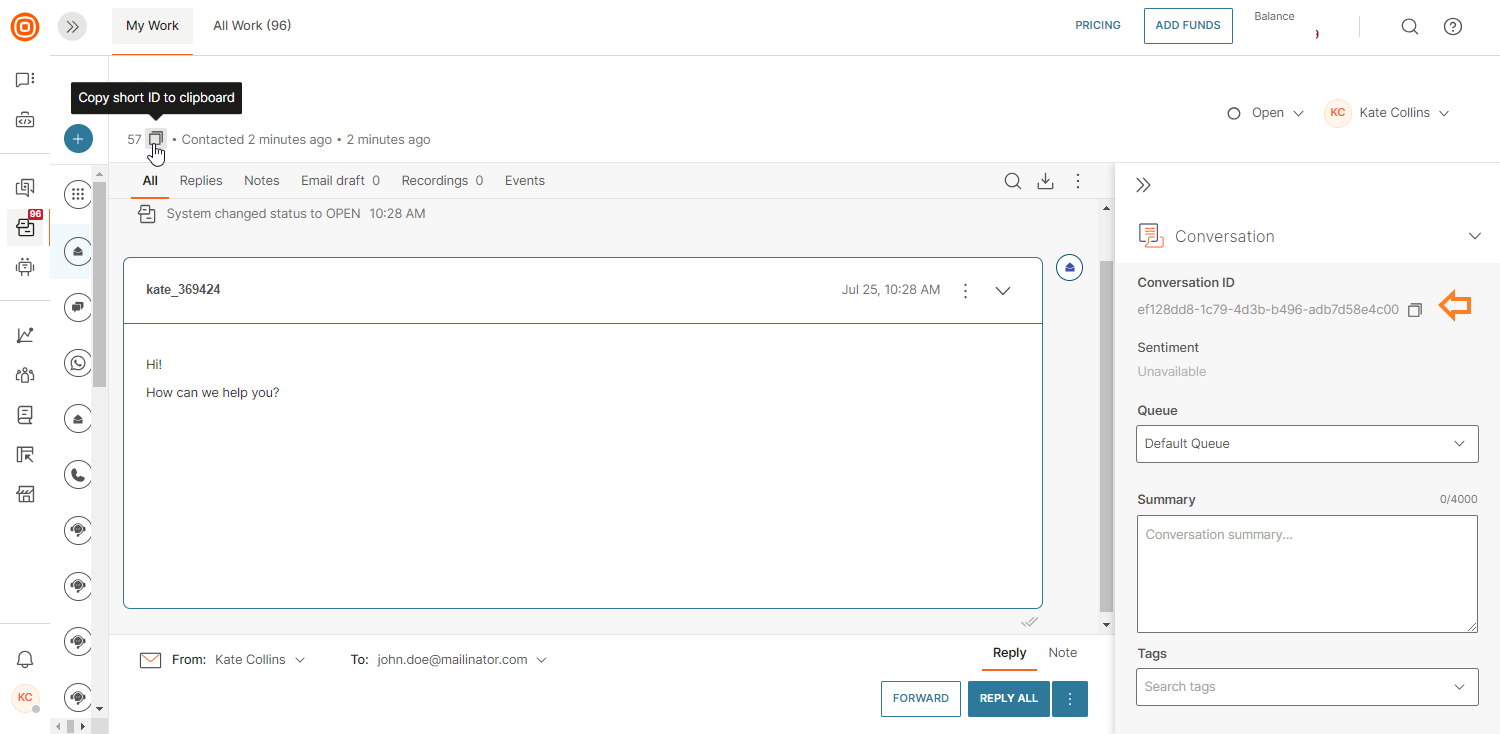
Internal conversations
Internal conversations enable agents to communicate with other agents (sort of behind the scenes). Every agent can create a new conversation and assign it to a specific queue. Agents who are part of that queue can be assigned to the conversation.
The recommendation is to enable Email as an internal communication channel within Conversations enables message exchange among registered email addresses, promoting efficient and organized communication. This functionality ensures conversations are streamlined, easily accessible, searchable, and organized.
Using email communication within Conversations offers numerous advantages, including:
- Rich text formatting - Unlike traditional internal conversations, email communication supports rich text formatting. Users can emphasize key points, use bullet points, and format text to enhance clarity and expressiveness.
- Templates- Create standardized templates for common responses, ensuring consistency and saving time.
- Macros- Implement macros to automate repetitive tasks, streamlining communication workflows.
- Workflows- Leverage automation to handle routine processes, reducing manual intervention.
- Routes - Efficiently direct messages to the right teams or individuals, ensuring timely responses.
- Auto-assignment - Automatically assign tasks or messages to designated individuals based on predefined rules, optimizing workload distribution.
- Integration - The email communication feature seamlessly integrates with existing functionalities, providing a cohesive and comprehensive solution for internal communication needs.
To create an internal conversation, click on the + sign and then Start Internal Conversation. After entering the necessary details and composing your message, click on the Start Internal Conversation button located in the bottom right corner.

Another option is to create it from the context card. You need to enter the queue and the subject and body of the internal conversation on that screen.
Conversation ID is the only optional parameter that you can use to link the internal conversation with an existing one. However, if an internal conversation is created from another conversation, the Conversation ID will be prepopulated.
When you create an internal conversation, the flow is more or less the same as with any other conversation, albeit with minor exceptions. Besides the agent who created the conversation and the agent assigned to actually handle the conversation, other users can also write messages.
Messages from the agent who's working on the conversation are displayed on the agent panel's right side. Messages from any other user working on this conversation are shown on the left side.
Related conversations
The Related conversations card enables agents to group multiple conversations that revolve around the same issue, providing better visibility, coordination, and context across customer interactions. This feature is especially helpful when customers reach out through different channels or reopen discussions on previously resolved topics.
The Related conversations card consists of three main sections:
- Main conversation - Represents the primary thread. You can assign other conversations as related only if the current one is a continuation of a previous interaction. Manual linking of main conversations is currently supported only for Facebook Posts used to route private messages to Messenger.
- Linked conversations - You can manually link conversations using their conversation ID, found in the URL of the respective ticket. Paste the ID into the Related conversations card to establish the link. In addition to manual linking, related conversations are also linked automatically - see the section below for more details. If multiple conversations are linked:
- The one being linked to becomes the main conversation.
- Others are considered related or follow-up threads.
- You can unlink a conversation at any time using the Unlink button.
- Follow-up conversations - These can only be created from conversations that have already been closed. This keeps the timeline clear and avoids confusion between ongoing and historical interactions. Read more about Follow-up conversations in the section below.
Automatic linking of related conversations
The automatic linking of related conversations detects and links tickets that originate from the same customer message sent to multiple support addresses within the same account. The system creates a visible relationship between them and ensures agents have full visibility into related interactions.
When a customer sends an inbound email to two registered Infobip senders, two separate inbound messages with the same external email message ID will be received by the system:
- The first inbound message will create Conversation A.
- The second inbound message will create Conversation B, but it will also recognize Conversation A as a potential parent.
As a result, the system will link the two conversations, establishing a connection between them.
Edge case: Ongoing conversation with one sender
If the customer is already engaged in an active conversation (Conversation A) with one Infobip sender and later decides to include a second Infobip sender in the email recipients:
- The system will first save the new message to Conversation A.
- Then, it will create Conversation B for the newly involved sender and recognize Conversation A as a potential parent.
- As with the initial case, the two conversations will be linked.
This linking ensures continuity across multiple senders and helps maintain context across related conversations.
To view related conversations:
- Go to Context cards → Related conversations, where all linked tickets are displayed.
- For each linked conversation, you can select the three-dots menu to either unlink the conversation or copy its conversation ID for reference or further actions.
Follow-up conversations
Follow-up conversations can only be created from conversations that have been closed. They help agents maintain continuity in customer interactions by tracking the progression of an issue and ensuring timely resolution.
Creating follow-up conversations allows you to document recurring or unresolved issues, monitor their status over time, and maintain a clear communication trail with the customer.
Follow-up conversations can be generated in the following ways:
- When a customer replies to an email tied to a previously closed conversation, the system automatically creates a new follow-up conversation and links it to the original one.
- If a customer uses the reply option through private direct message in Facebook Posts, the system automatically opens a new Messenger conversation as a follow-up.
- You can also manually create a follow-up from any closed conversation using the Related conversations card in the agent interface.
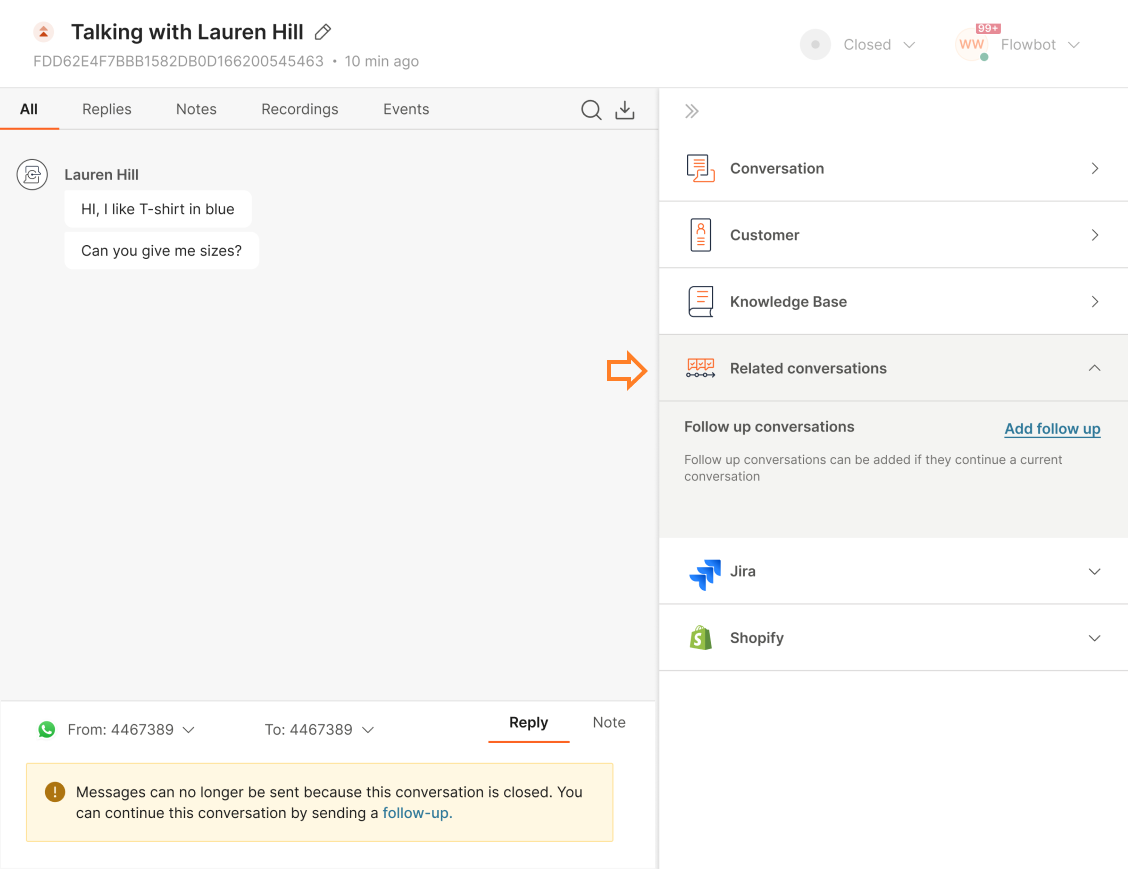
When the Add follow-up button is selected, a new window opens, allowing the user to start a new conversation. The From and To fields are automatically populated based on the previous conversation and cannot be changed.
The system also copies any existing form and its associated attributes from the original conversation. These details appear in the new conversation screen, where the you have the option to discard them if needed.
If the follow-up conversation is sent via email, it will include a predefined subject line and all necessary technical headers to ensure that the message appears in the same thread on the end customer’s side.
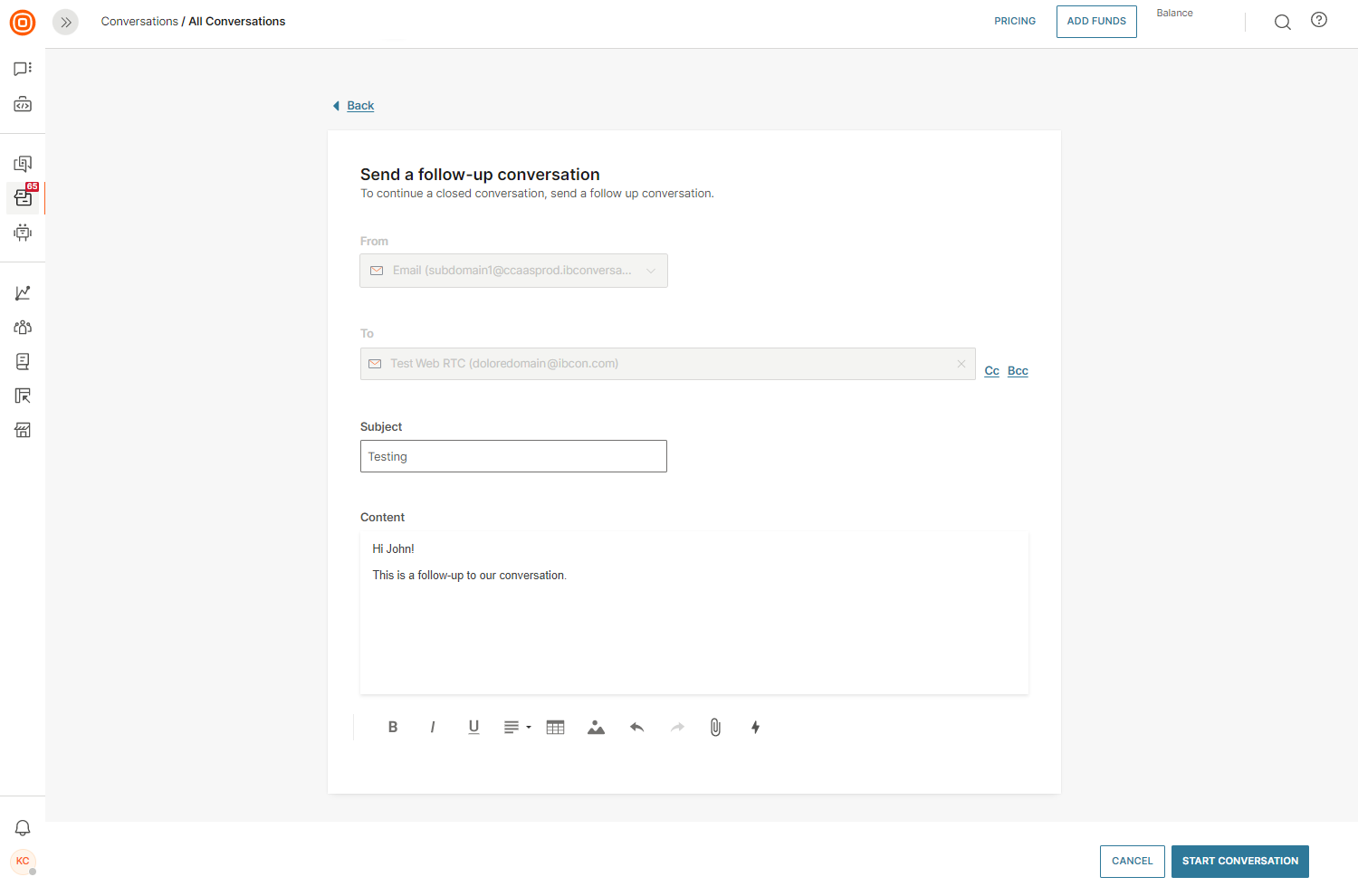
Once a follow-up conversation is created, a note will appear in the conversation view indicating that it is linked to a previous conversation. This note includes a clickable link that allows you to quickly access the original conversation for context and reference.
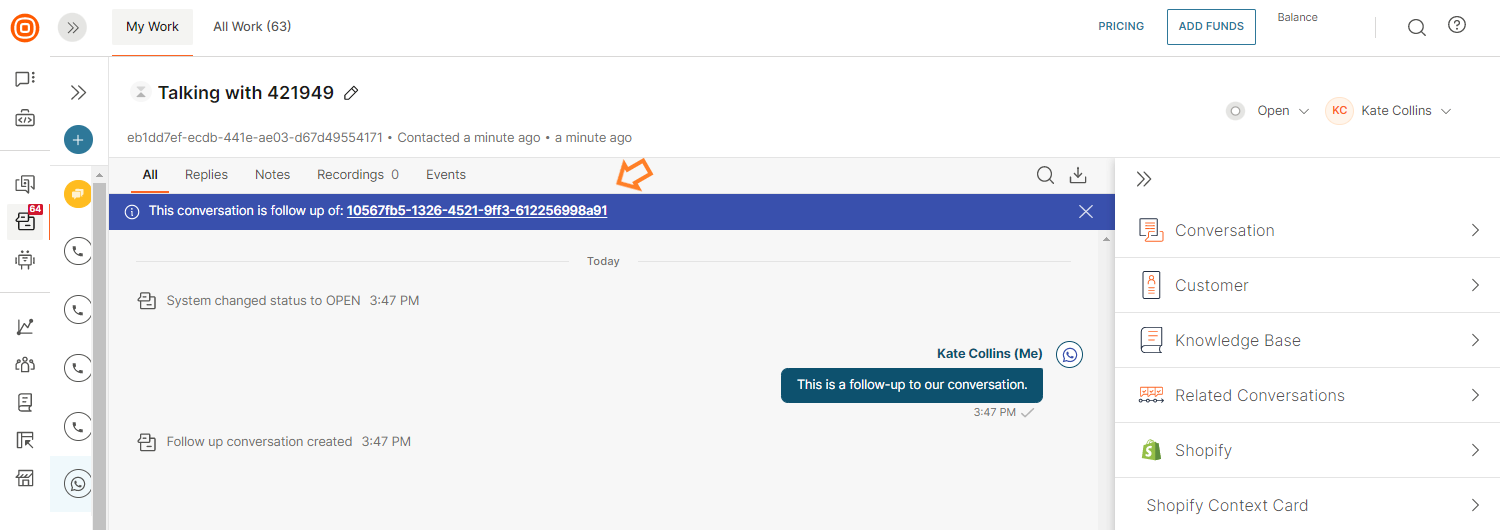
The follow-up link is working only for channels that support the creation of new conversations by agents.
If a macro is applied during the creation of the follow-up conversation, and it contains form-related data, the system will handle form and field values based on the following logic:
- If the macro includes both a form and filled form fields, those values override the follow-up data and are applied to the new conversation.
- If the macro does not include a form or any filled fields, the form and fields from the original (follow-up) conversation are retained.
- If the macro includes a form but no filled fields, the macro's form is applied, while the field values are taken from the follow-up conversation.
- If the agent manually changes the form during the creation of the follow-up conversation, the field values from the follow-up are preserved.
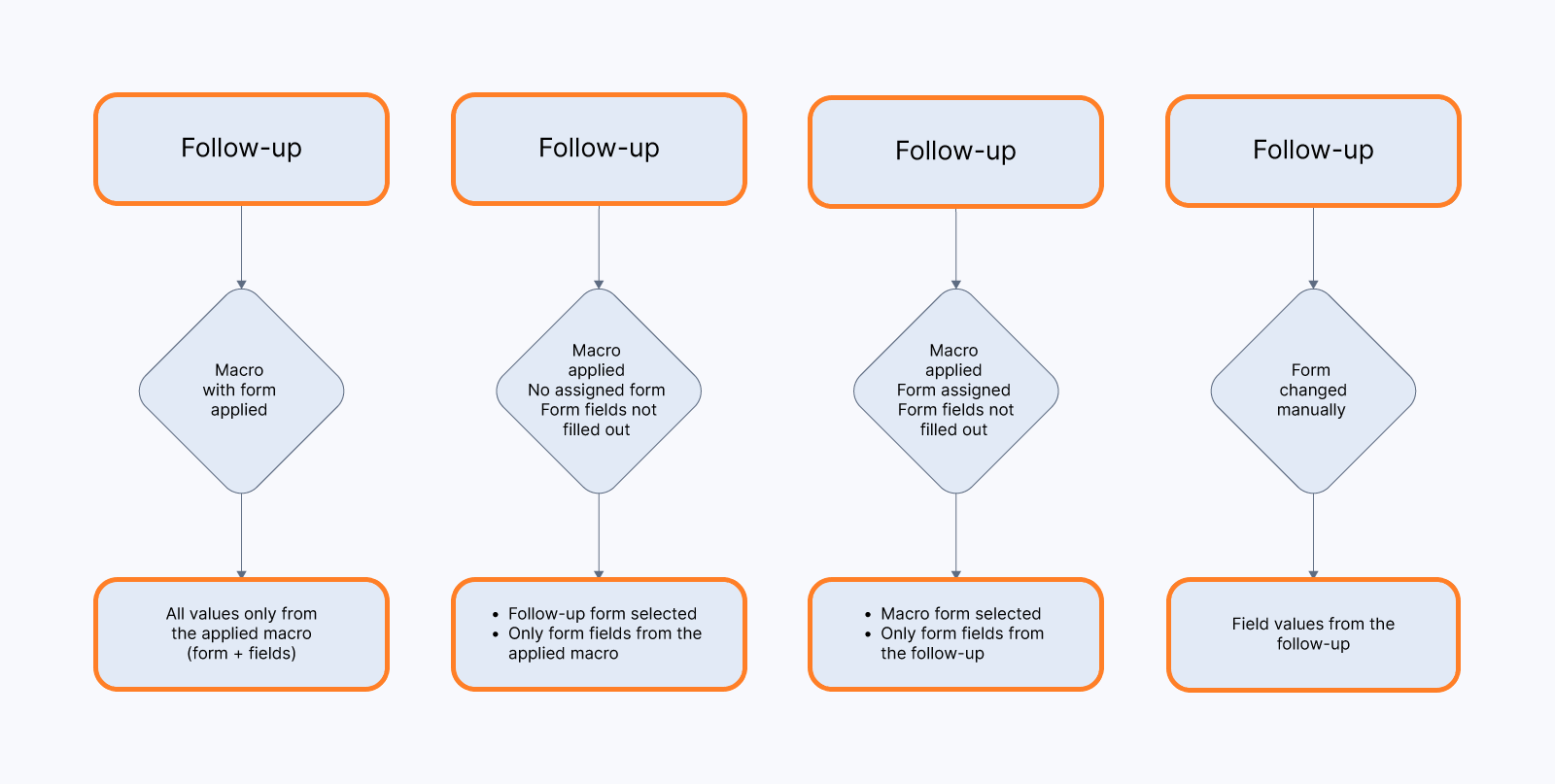
Conversation status indicators
The color of the bubbles in linked and follow-up conversations are indicating the status of the conversation:
- In progress ⚪
- Waiting 🟡
- Solved 🟢
- Closed ⚫

Knowledge Base
Agents can use the Infobip Knowledge Base, which is a shared component, to share knowledge either within their organization or when talking to customers.
It allows them to access any manuals or important pieces of content that the supervisors/managers have created and shared across the organization and thus help out customers with any frequently asked questions.
To use the Knowledge Base, you need to contact your dedicated account manager to enable it.
While in a conversation with a customer, the agents can access the Knowledge Base articles by searching for a particular piece in the customer context card. To search for an article, simply start typing and it will appear in the results list.
Also, agents will see suggested knowledge base articles. These will appear in the context card based on five previous active conversations between the agent and the end user.
If the agent manually searches for something in the knowledge base, these automatic suggestions will disappear for a moment.
Service-level agreement
SLA in My Work offers a broader and intuitive view of policies applicable to each conversation:
- Counter time for valid SLA that always represents two-time counters:
- First response time and Total resolution time
- Or Next reply time and Total resolution time
- Red color indicates that the breach has already happened
- Green color indicates that the breach has not happened yet
Severity
This drop-down consists of all severities the supervisor has set in SLA policies, which can be changed to different severity per agent.
If the severity has changed, all currently counted times will be updated to follow the SLA policy configuration.
The list of conversations assigned to an agent in My Work is ordered based on the highest valid breach from the ones with no breach yet to the ones with the longest time to achieve the breach of SLA. In case a conversation has already been breached and the breach is still valid and growing, this information will also be displayed in My Work.
In case any time counter has been paused due to the change of the status (for example, Solved, Closed), this will be displayed instead of the On Hold status in the top right corner of the agent panel.
Logs
The Logs page is divided into two tabs:
- Conversation logs: These display events related to specific conversations.
- Audit logs: These record configuration events or changes made at the queue, route, or account level.
However, keep in mind that the page displays different views based on your role within Conversations:
- Agent for Conversations does not have access to the Logs page.
- Conversations setup can view only Audit logs.
- Supervisor for Conversations can view only Conversation logs.
- Users with both Supervisor for Conversations and Conversations setup roles can access both Audit and Conversation logs, displayed in separate tabs.
Conversation logs
The Conversation logs page consolidates all events mentioned in Conversation events, presented chronologically with detailed information about who made changes to specific conversations.
The table shows the following information:
- Done by
- Event
- From
- To
- Date
- Conversation link
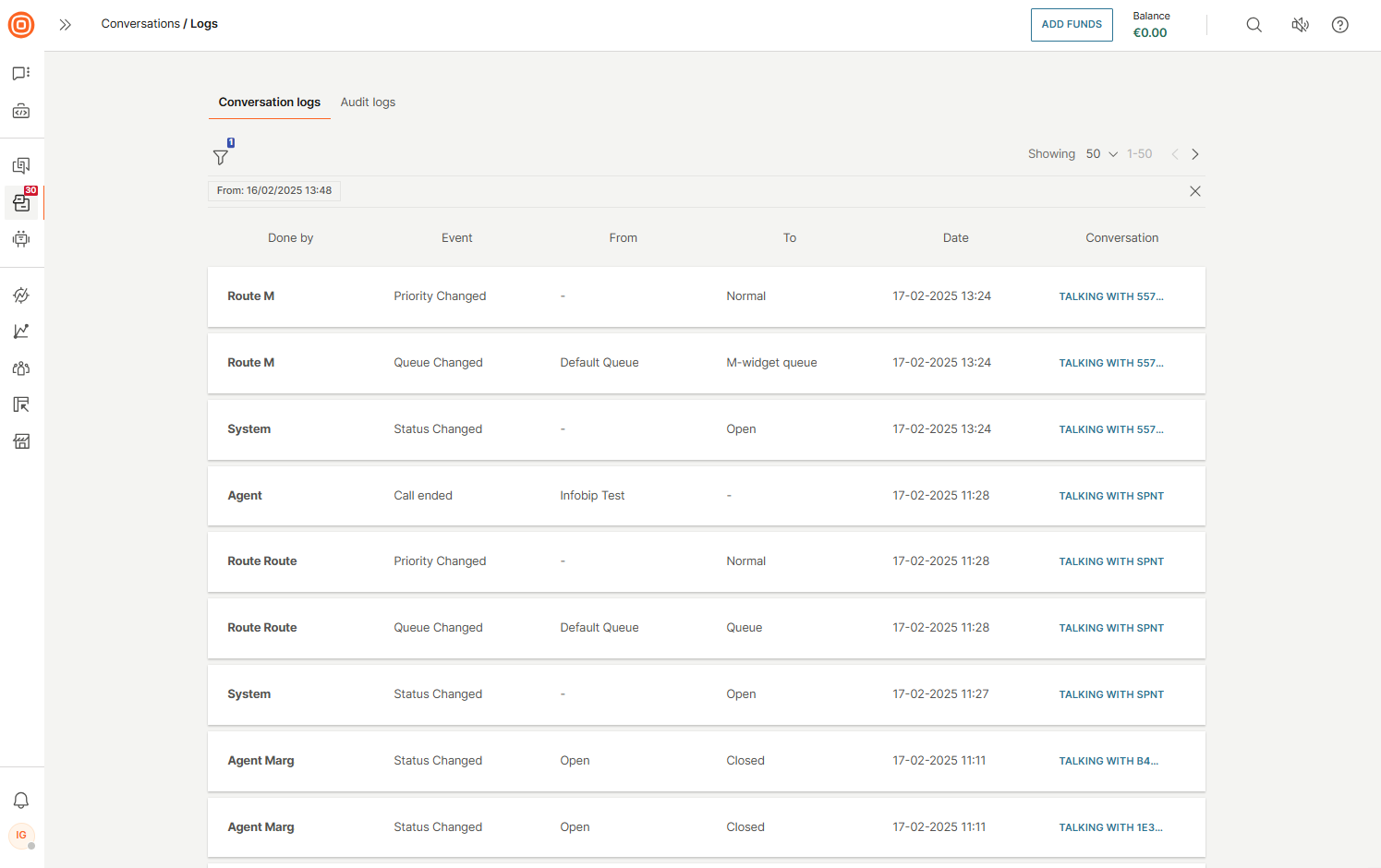
You can also filter these logs by:
- Event
- Done by
- From
- To
Choose the wanted filters and select the Apply Filters button to refine your results.

Audit logs
BETA
The Audit logs tab displays records of changes made to various objects within Conversations settings. These logs are distinct from Conversation logs, as the latter relates only to the conversations entity.
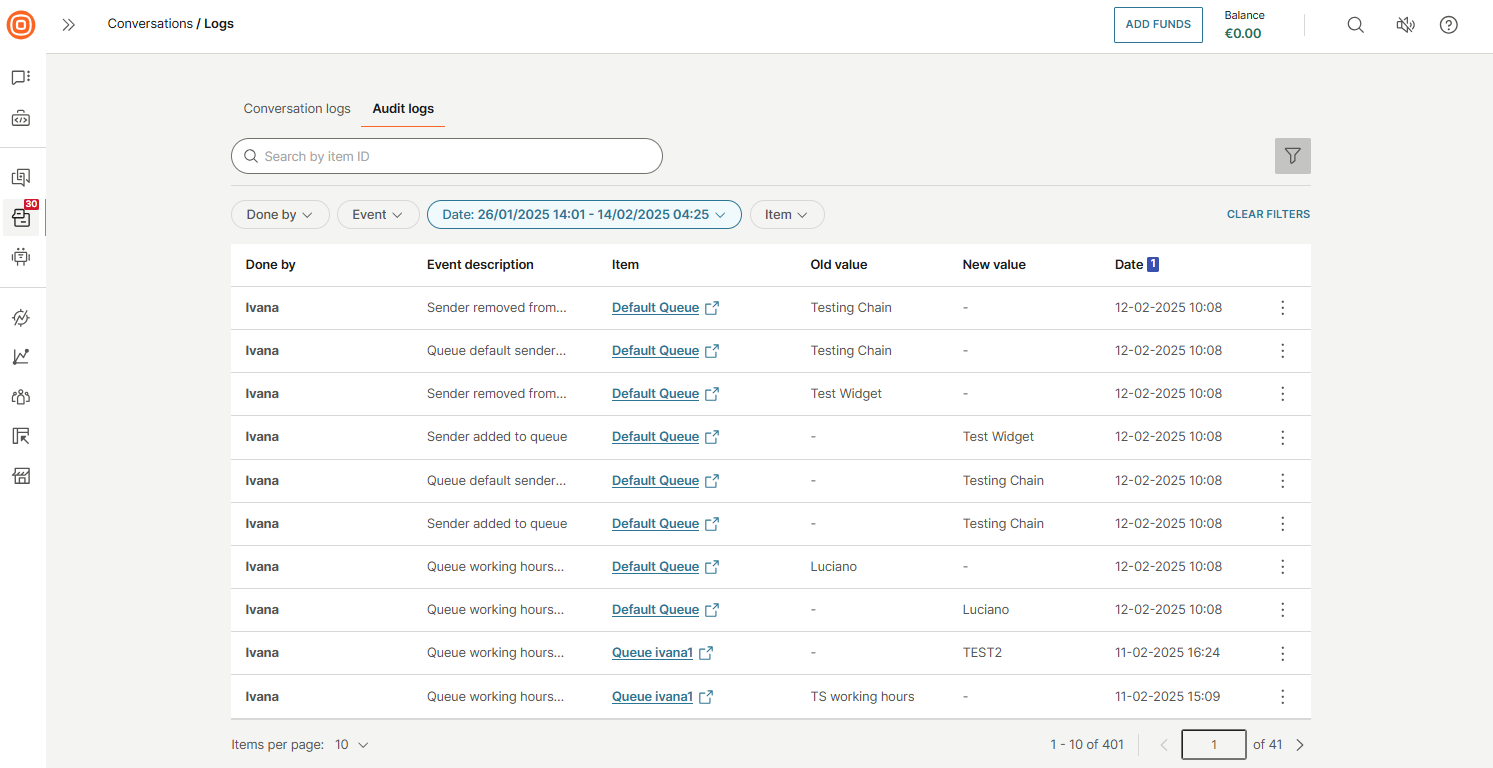
You can use the Search by field to find audit logs by the item ID, or you can use the following filters:
- Done by:
- User
- System
- API user
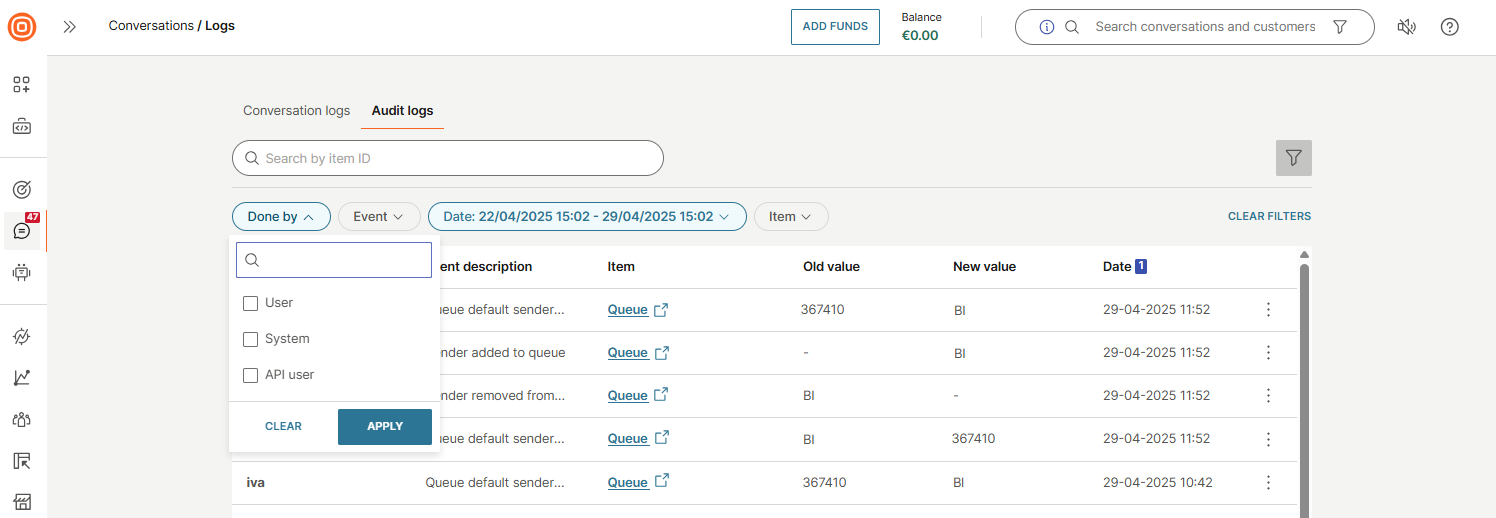
- Event:
- Tag
- Tag created
- Tag renamed
- Tag deleted
- Queue
- Queue created
- Queue renamed
- Queue deleted
- Queue working hours changed
- Agent added to queue
- Agent removed from queue
- Sender added to queue
- Sender removed from queue
- Queue default sender changed
- Assignment method changed for queue
- Account configuration
- Account capacity live messaging created
- Account capacity live messaging changed
- Account capacity live messaging deleted
- Account capacity live chat created
- Account capacity live chat changed
- Account capacity live chat deleted
- Account capacity voice created
- Account capacity voice changed
- Account capacity voice deleted
- Account capacity email created
- Account capacity email changed
- Account capacity email deleted
- Agent configuration
- Agent capacity live messaging created
- Agent capacity live messaging changed
- Agent capacity live messaging deleted
- Agent capacity live chat created
- Agent capacity live chat changed
- Agent capacity live chat deleted
- Agent capacity voice created
- Agent capacity voice changed
- Agent capacity voice deleted
- Agent capacity email created
- Agent capacity email changed
- Agent capacity email deleted
- Route
- Route created
- Route renamed
- Route destination queue changed
- Route priority changed
- Route enabled changed
- Route only during working hours changed
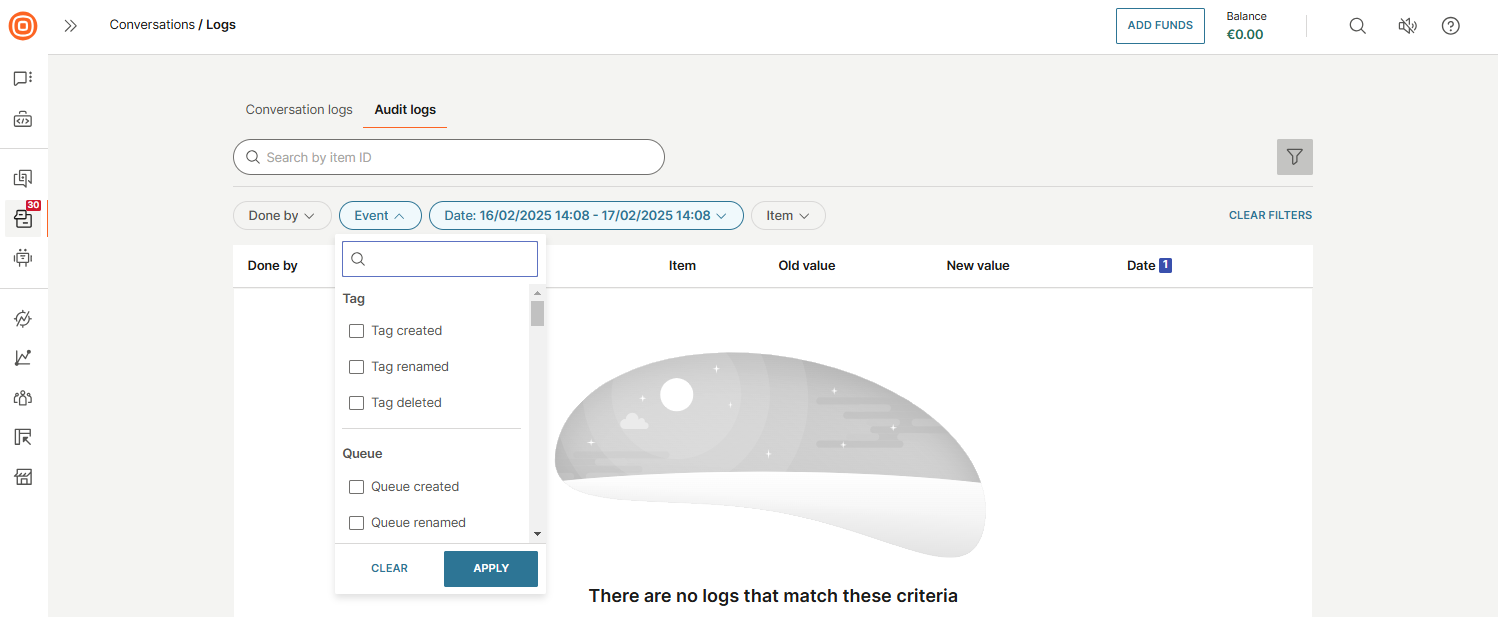
- Tag
- Date:
- From - date and time
- To - date and time

- Item:
- Tag
- Queue
- Agent configuration
- Account configuration
- Route

Audit logs can be filtered by specific criteria such as tags, queues, events, and more. For example, if you select Item → Tag, an additional filter with a drop-down menu will appear, allowing you to choose the desired tags.
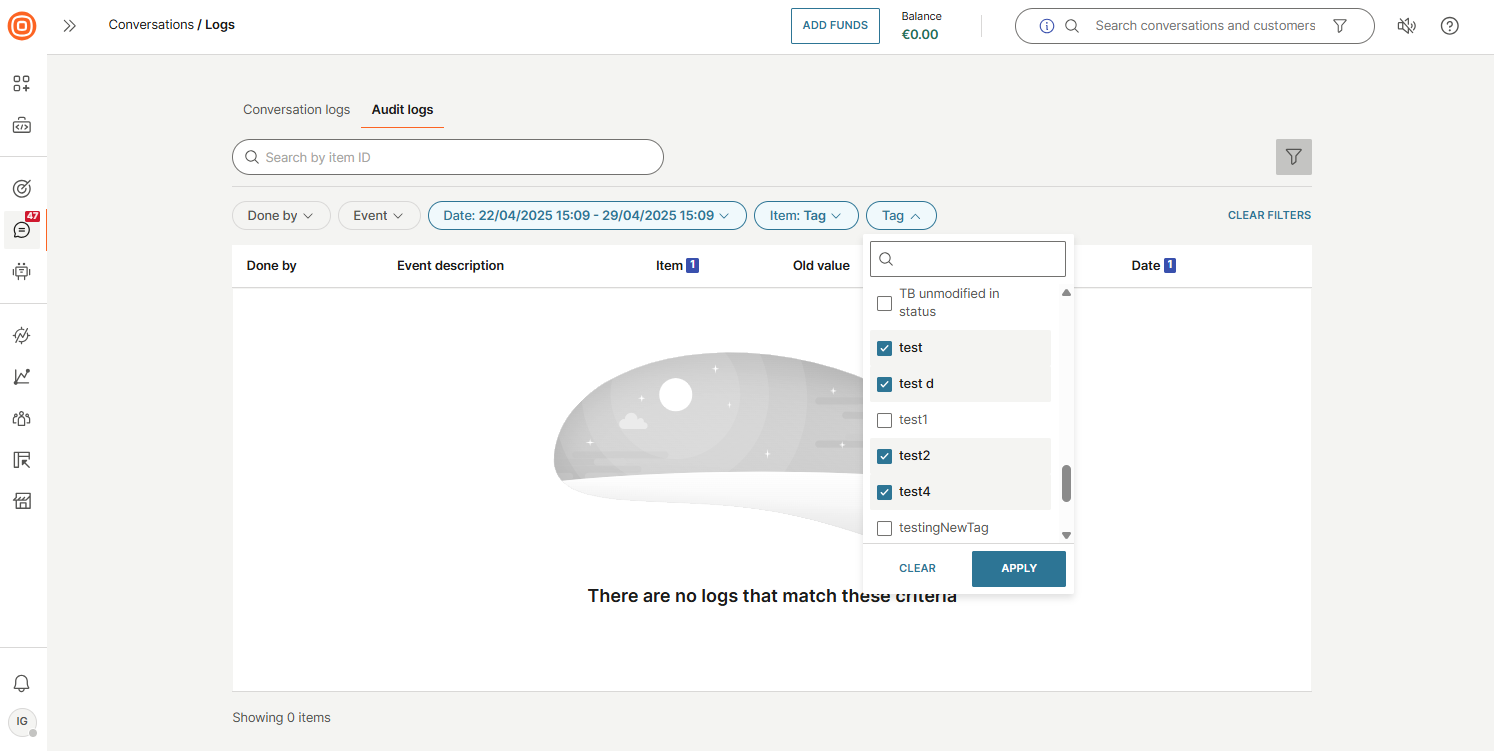
Additionally, you can select the three dots menu next to any log → click View events related to this item to see a list of events that occurred for that specific item.
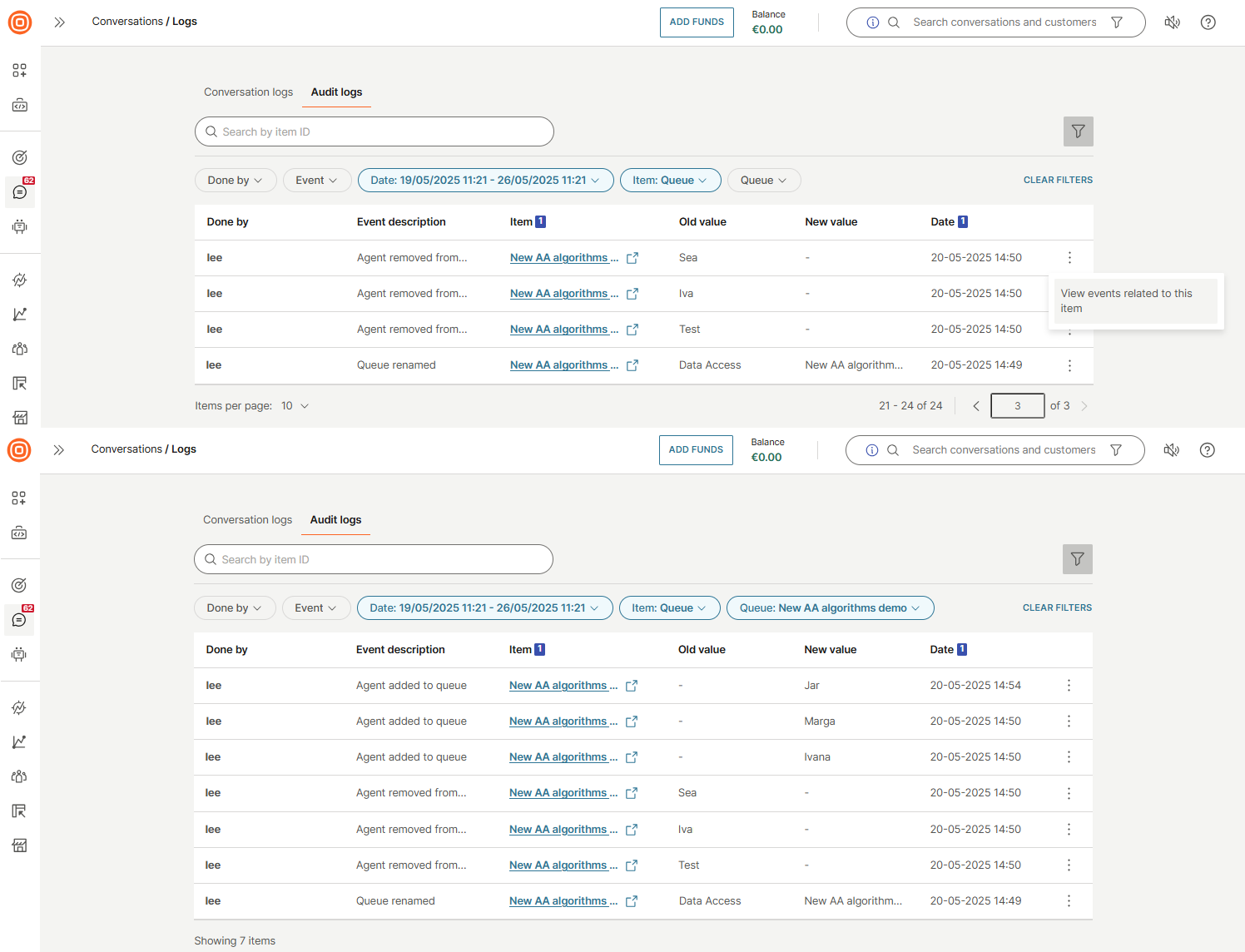
Manage conversations
Topic
Each conversation gets a default name that can be changed anytime - Talking with ‘Name of the customer’ and a unique conversation ID.
Priority
Conversation priority is visible in the header and is assigned according to the routing rules. Priority can be changed manually at any time.
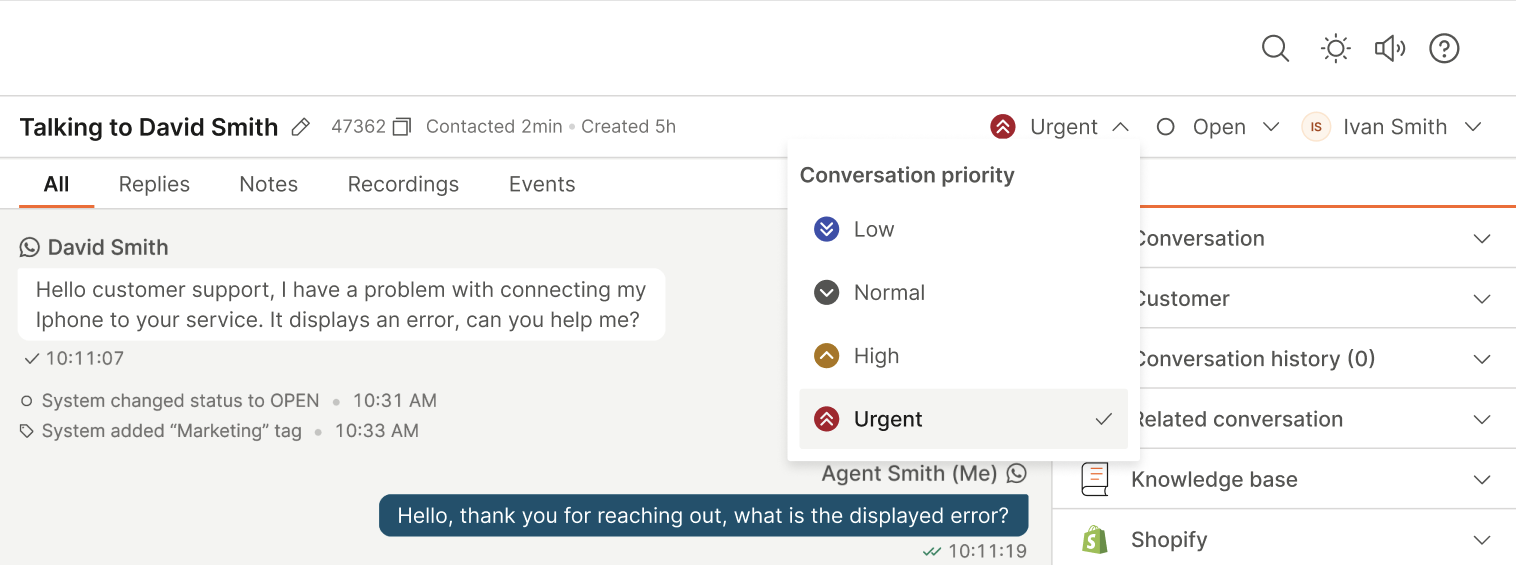
Status
There are four possible conversation statuses:
- Open
- Waiting
- Solved
- Closed
Agents can manually change the status while interacting with customers. Statuses help transition from an omnichannel continuous conversation to a ticket-based system as follows:
| Status | Description |
|---|---|
| Open | The default status when a conversation is created. |
| Waiting | When the customer is waiting for the agent’s reply, the agent changes the status from Open to Waiting. This status indicates that the next action is expected from the agent, such as when an issue is escalated and the customer is awaiting feedback or additional information. |
| Pending – Stop SLA | Used when the agent is waiting for a response from the customer, another operator, or an account manager, and wants to pause the SLA timer during this waiting period. |
| Solved | If the agent believes the issue is resolved, they change the status to Solved. No further interaction is expected. If the customer replies, communication continues in the same conversation. |
| Closed | When the agent is certain the issue is resolved, the conversation is marked as Closed and removed from the agent’s to-do list. |
Conversation status colors
Different bubble colors indicate different statuses in the My Work panel:
| Color | Statuses | Meaning |
|---|---|---|
| ⚪ White | Open | Default status. A new conversation is active and in progress. |
| 🟢 Green | Solved | No further interaction is expected. If the customer replies, the same conversation is reopened. |
| 🟡 Yellow | Waiting, Pending - Stop SLA | The conversation is paused while the agent or customer awaits a response. |
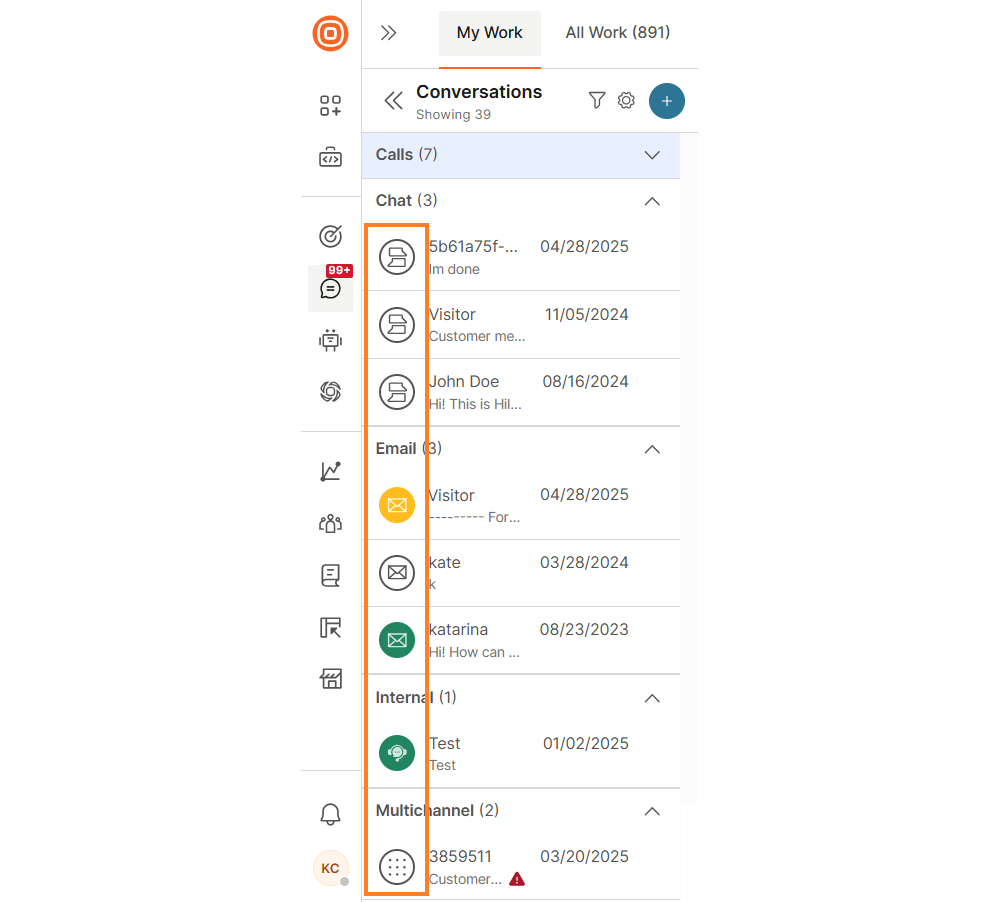
Incoming messages automatically change the conversation status from Waiting or Solved back to Open. Conversation statuses also influence the Analytics section, where you can view conversations categorized by their current status.
Assignee
Conversation can have two assignee statuses, Assigned (containing information to whom it is assigned) and Unassigned. You can check and change the status in the upper right corner.
Click the drop-down icon to see a list of all agents. The user can then assign or unassign a conversation to any agent. Use the Search agents option if the agent list is too long for scrolling.
If a conversation is closed, you cannot change the assignee.
Queue
On the right-side panel in the Conversations card, check to which queue the selected conversation is assigned to.
Summary
Summary is a short text input used to write a quick summary about the conversation.
Tags
Tags can be assigned to conversations to better categorize a conversation topics or customer intent. They are connected to the dashboard where supervisors can analyze the number of conversations per specific tag.
Learn more about Tags.
Customer details
Conversation is built on a combination of participants (customer and agents) and messages exchanged between participants. A customer participating in a conversation can be known or unknown. Customer is known if their contact number is connected to the People profile. In case of a known customer, the agent can see on the right-side panel default customer attributes:
- Customer name - Associated with that destination number/ID in People.
- Gender - If associated with person in People.
- City - If associated with person in People.
- Country - If associated with person in People.
More customer details can be found using the View and Edit link in People. Agent can update customer attributes in People (for example, change name, add destination, add tags, and more).
Learn more about Customer details.
Channels
Conversations are either established over one channel where the channel icon represents a single channel in use or consists of multiple channels within a single conversation.
Omnichannel conversations have a special icon and they can be created in the following cases:
- The customer sends messages over two or more communication channels regarding the same topic and the agent merges the conversations.
- Agents initiate a conversation over a new communication channel within one conversation. Learn how to change channels and which channels are supported in Conversations.
Conversations mobile app
Refer to the Conversations mobile app documentation to learn how to manage customer interactions, respond to messages, and collaborate with your team from any location.